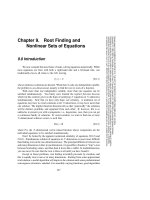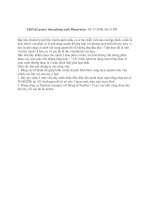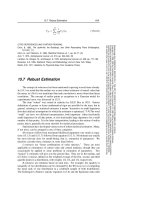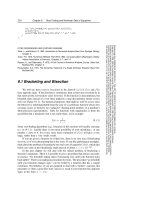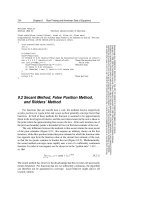Tài liệu Root Finding and Nonlinear Sets of Equations part 8 ppt
Bạn đang xem bản rút gọn của tài liệu. Xem và tải ngay bản đầy đủ của tài liệu tại đây (205.42 KB, 11 trang )
9.7 Globally Convergent Methods for Nonlinear Systems of Equations
383
Sample page from NUMERICAL RECIPES IN C: THE ART OF SCIENTIFIC COMPUTING (ISBN 0-521-43108-5)
Copyright (C) 1988-1992 by Cambridge University Press.Programs Copyright (C) 1988-1992 by Numerical Recipes Software.
Permission is granted for internet users to make one paper copy for their own personal use. Further reproduction, or any copying of machine-
readable files (including this one) to any servercomputer, is strictly prohibited. To order Numerical Recipes books,diskettes, or CDROMs
visit website or call 1-800-872-7423 (North America only),or send email to (outside North America).
such methods can still occasionally fail by coming to rest on a local minimum of
F, they often succeed where a direct attack via Newton’s method alone fails. The
next section deals with these methods.
CITED REFERENCES AND FURTHER READING:
Acton, F.S. 1970,
Numerical Methods That Work
; 1990, corrected edition (Washington: Mathe-
matical Association of America), Chapter 14. [1]
Ostrowski, A.M. 1966,
Solutions of Equations and Systems of Equations
, 2nd ed. (New York:
Academic Press).
Ortega, J., and Rheinboldt, W. 1970,
Iterative Solution of Nonlinear Equations in Several Vari-
ables
(New York: Academic Press).
9.7 Globally Convergent Methods for Nonlinear
Systems of Equations
We have seen that Newton’s method for solving nonlinear equations has an
unfortunate tendency to wander off into the wild blue yonder if the initial guess
is not sufficiently close to the root. A global method is one that converges to
a solution from almost any starting point. In this section we will develop an
algorithm that combines the rapid local convergence of Newton’s method with a
globally convergent strategy that will guarantee some progress towards the solution
at each iteration. The algorithm is closely related to the quasi-Newton method of
minimization which we will describe in §10.7.
Recall our discussion of §9.6: the Newton step for the set of equations
F(x)=0 (9.7.1)
is
x
new
= x
old
+ δx (9.7.2)
where
δx = −J
−1
· F (9.7.3)
Here J is the Jacobian matrix. How do we decide whether to accept the Newton step
δx? A reasonable strategy is to require that the step decrease |F|
2
= F · F.Thisis
the same requirement we would impose if we were trying to minimize
f =
1
2
F · F (9.7.4)
(The
1
2
is for later convenience.) Every solution to (9.7.1) minimizes (9.7.4), but
there may be local minima of (9.7.4) that are not solutions to (9.7.1). Thus, as
already mentioned, simply applying one of our minimum finding algorithms from
Chapter 10 to (9.7.4) is not a good idea.
To develop a better strategy, note that the Newton step (9.7.3) is a descent
direction for f:
∇f · δx =(F·J)·(−J
−1
·F)=−F·F<0(9.7.5)
384
Chapter 9. Root Finding and Nonlinear Sets of Equations
Sample page from NUMERICAL RECIPES IN C: THE ART OF SCIENTIFIC COMPUTING (ISBN 0-521-43108-5)
Copyright (C) 1988-1992 by Cambridge University Press.Programs Copyright (C) 1988-1992 by Numerical Recipes Software.
Permission is granted for internet users to make one paper copy for their own personal use. Further reproduction, or any copying of machine-
readable files (including this one) to any servercomputer, is strictly prohibited. To order Numerical Recipes books,diskettes, or CDROMs
visit website or call 1-800-872-7423 (North America only),or send email to (outside North America).
Thus our strategy is quite simple: We always first try the full Newton step,
because once we are close enough to the solutionwe will get quadratic convergence.
However, we check at each iteration that the proposed step reduces f. If not, we
backtrack along the Newton direction until we have an acceptable step. Because the
Newton step is a descent direction for f, we are guaranteed to find an acceptable step
by backtracking. We will discuss the backtracking algorithm in more detail below.
Note that this method essentially minimizes f by taking Newton steps designed
to bring F to zero. This is not equivalent to minimizing f directly by taking Newton
steps designed to bring ∇f to zero. While the method can still occasionally fail by
landing on a local minimum of f, this is quite rare in practice. The routine newt
below will warn you if this happens. The remedy is to try a new starting point.
Line Searches and Backtracking
When we are not close enoughto the minimum of f, taking the full Newton step p = δx
need not decrease the function; we may move too far for the quadratic approximation to
be valid. All we are guaranteed is that initially f decreases as we move in the Newton
direction. So the goal is to move to a new point x
new
along the direction of the Newton
step p, but not necessarily all the way:
x
new
= x
old
+ λp, 0 <λ≤1(9.7.6)
The aim is to find λ so that f(x
old
+ λp) has decreased sufficiently. Until the early 1970s,
standard practice was to choose λ so that x
new
exactly minimizes f in the direction p.
However, we now know that it is extremely wasteful of function evaluations to do so. A
better strategy is as follows: Since p is always the Newton direction in our algorithms, we
first try λ =1, the full Newton step. This will lead to quadratic convergence when x is
sufficiently close to the solution. However, if f(x
new
) does not meet our acceptance criteria,
we backtrackalong the Newton direction, trying a smaller value of λ, until we find a suitable
point. Since the Newton direction is a descent direction, we are guaranteed to decrease f
for sufficiently small λ.
What should the criterion for accepting a step be? It is not sufficient to require merely
that f (x
new
) <f(x
old
). This criterion can fail to converge to a minimum of f in one of
two ways. First, it is possible to construct a sequence of steps satisfying this criterion with
f decreasing too slowly relative to the step lengths. Second, one can have a sequence where
the step lengths are too small relative to the initial rate of decrease of f.(Forexamplesof
such sequences, see
[1]
, p. 117.)
A simple way to fix the first problem is to require the average rate of decrease of f to
be at least some fraction α of the initial rate of decrease ∇f · p:
f(x
new
) ≤ f(x
old
)+α∇f·(x
new
− x
old
)(9.7.7)
Here the parameter α satisfies 0 <α<1. We can get away with quite small values of
α; α =10
−4
is a good choice.
The second problem can be fixed by requiring the rate of decrease of f at x
new
to be
greater than some fraction β of the rate of decrease of f at x
old
. In practice, we will not
need to impose this second constraint because our backtracking algorithm will have a built-in
cutoff to avoid taking steps that are too small.
Here is the strategy for a practical backtracking routine: Define
g(λ) ≡ f(x
old
+ λp)(9.7.8)
so that
g
(λ)=∇f·p (9.7.9)
If we need to backtrack, then we model g with the most current information we have and
choose λ to minimize the model. We start with g(0) and g
(0) available. The first step is
9.7 Globally Convergent Methods for Nonlinear Systems of Equations
385
Sample page from NUMERICAL RECIPES IN C: THE ART OF SCIENTIFIC COMPUTING (ISBN 0-521-43108-5)
Copyright (C) 1988-1992 by Cambridge University Press.Programs Copyright (C) 1988-1992 by Numerical Recipes Software.
Permission is granted for internet users to make one paper copy for their own personal use. Further reproduction, or any copying of machine-
readable files (including this one) to any servercomputer, is strictly prohibited. To order Numerical Recipes books,diskettes, or CDROMs
visit website or call 1-800-872-7423 (North America only),or send email to (outside North America).
always the Newton step, λ =1. If this step is not acceptable, we have available g(1) as
well. We can therefore model g(λ) as a quadratic:
g(λ) ≈ [g(1) − g(0) − g
(0)]λ
2
+ g
(0)λ + g(0) (9.7.10)
Taking the derivative of this quadratic, we find that it is a minimum when
λ = −
g
(0)
2[g(1) − g(0) − g
(0)]
(9.7.11)
Since the Newton step failed, we can show that λ
<
∼
1
2
for small α. We need to guard against
too small a value of λ, however. We set λ
min
=0.1.
On second and subsequent backtracks, we model g asacubicinλ, using the previous
value g(λ
1
) and the second most recent value g(λ
2
):
g(λ)=aλ
3
+ bλ
2
+ g
(0)λ + g(0) (9.7.12)
Requiring this expression to give the correct values of g at λ
1
and λ
2
gives two equations
that can be solved for the coefficients a and b:
a
b
=
1
λ
1
− λ
2
1/λ
2
1
−1/λ
2
2
−λ
2
/λ
2
1
λ
1
/λ
2
2
·
g(λ
1
) − g
(0)λ
1
− g(0)
g(λ
2
) − g
(0)λ
2
− g(0)
(9.7.13)
The minimum of the cubic (9.7.12) is at
λ =
−b +
b
2
− 3ag
(0)
3a
(9.7.14)
We enforce that λ lie between λ
max
=0.5λ
1
and λ
min
=0.1λ
1
.
The routine has two additional features, a minimum step length alaminand a maximum
step length stpmax. lnsrch will also be used in the quasi-Newton minimization routine
dfpmin in the next section.
#include <math.h>
#include "nrutil.h"
#define ALF 1.0e-4 Ensures sufficient decrease in function value.
#define TOLX 1.0e-7 Convergence criterion on ∆x.
void lnsrch(int n, float xold[], float fold, float g[], float p[], float x[],
float *f, float stpmax, int *check, float (*func)(float []))
Given an
n
-dimensional point
xold[1..n]
, the value of the function and gradient there,
fold
and
g[1..n]
, and a direction
p[1..n]
, finds a new point
x[1..n]
along the direction
p
from
xold
where the function
func
has decreased “sufficiently.” The new function value is returned
in
f
.
stpmax
is an input quantity that limits the length of the steps so that you do not try to
evaluate the function in regions where it is undefined or subject to overflow.
p
is usually the
Newton direction. The output quantity
check
is false (0) on a normal exit. It is true (1) when
x
is too close to
xold
. In a minimization algorithm, this usually signals convergence and can
be ignored. However, in a zero-finding algorithm the calling program should check whether the
convergence is spurious. Some “difficult” problems may require double precision in this routine.
{
int i;
float a,alam,alam2,alamin,b,disc,f2,rhs1,rhs2,slope,sum,temp,
test,tmplam;
*check=0;
for (sum=0.0,i=1;i<=n;i++) sum += p[i]*p[i];
sum=sqrt(sum);
if (sum > stpmax)
for (i=1;i<=n;i++) p[i] *= stpmax/sum; Scale if attempted step is too big.
for (slope=0.0,i=1;i<=n;i++)
slope += g[i]*p[i];
if (slope >= 0.0) nrerror("Roundoff problem in lnsrch.");
test=0.0; Compute λ
min
.
for (i=1;i<=n;i++) {
386
Chapter 9. Root Finding and Nonlinear Sets of Equations
Sample page from NUMERICAL RECIPES IN C: THE ART OF SCIENTIFIC COMPUTING (ISBN 0-521-43108-5)
Copyright (C) 1988-1992 by Cambridge University Press.Programs Copyright (C) 1988-1992 by Numerical Recipes Software.
Permission is granted for internet users to make one paper copy for their own personal use. Further reproduction, or any copying of machine-
readable files (including this one) to any servercomputer, is strictly prohibited. To order Numerical Recipes books,diskettes, or CDROMs
visit website or call 1-800-872-7423 (North America only),or send email to (outside North America).
temp=fabs(p[i])/FMAX(fabs(xold[i]),1.0);
if (temp > test) test=temp;
}
alamin=TOLX/test;
alam=1.0; Always try full Newton step first.
for (;;) { Start of iteration loop.
for (i=1;i<=n;i++) x[i]=xold[i]+alam*p[i];
*f=(*func)(x);
if (alam < alamin) { Convergence on ∆x. For zero find-
ing, the calling program should
verify the convergence.
for (i=1;i<=n;i++) x[i]=xold[i];
*check=1;
return;
} else if (*f <= fold+ALF*alam*slope) return; Sufficient function decrease.
else { Backtrack.
if (alam == 1.0)
tmplam = -slope/(2.0*(*f-fold-slope)); First time.
else { Subsequent backtracks.
rhs1 = *f-fold-alam*slope;
rhs2=f2-fold-alam2*slope;
a=(rhs1/(alam*alam)-rhs2/(alam2*alam2))/(alam-alam2);
b=(-alam2*rhs1/(alam*alam)+alam*rhs2/(alam2*alam2))/(alam-alam2);
if (a == 0.0) tmplam = -slope/(2.0*b);
else {
disc=b*b-3.0*a*slope;
if (disc < 0.0) tmplam=0.5*alam;
else if (b <= 0.0) tmplam=(-b+sqrt(disc))/(3.0*a);
else tmplam=-slope/(b+sqrt(disc));
}
if (tmplam > 0.5*alam)
tmplam=0.5*alam; λ ≤ 0.5λ
1
.
}
}
alam2=alam;
f2 = *f;
alam=FMAX(tmplam,0.1*alam); λ ≥ 0.1λ
1
.
} Try again.
}
Here now is the globally convergent Newton routine newt that uses lnsrch. A feature
of newt is that you need not supply the Jacobianmatrix analytically; the routine will attempt to
compute the necessary partial derivatives of F by finite differences in the routine fdjac.This
routine uses some of the techniques described in §5.7 for computing numericalderivatives. Of
course, you can always replace fdjac with a routine that calculates the Jacobian analytically
if this is easy for you to do.
#include <math.h>
#include "nrutil.h"
#define MAXITS 200
#define TOLF 1.0e-4
#define TOLMIN 1.0e-6
#define TOLX 1.0e-7
#define STPMX 100.0
Here
MAXITS
is the maximum number of iterations;
TOLF
sets the convergence criterion on
function values;
TOLMIN
sets the criterion for deciding whether spurious convergence to a
minimum of
fmin
has occurred;
TOLX
is the convergence criterion on δx;
STPMX
is the scaled
maximum step length allowed in line searches.
int nn; Global variables to communicate with fmin.
float *fvec;
void (*nrfuncv)(int n, float v[], float f[]);
#define FREERETURN {free_vector(fvec,1,n);free_vector(xold,1,n);\
free_vector(p,1,n);free_vector(g,1,n);free_matrix(fjac,1,n,1,n);\
free_ivector(indx,1,n);return;}
9.7 Globally Convergent Methods for Nonlinear Systems of Equations
387
Sample page from NUMERICAL RECIPES IN C: THE ART OF SCIENTIFIC COMPUTING (ISBN 0-521-43108-5)
Copyright (C) 1988-1992 by Cambridge University Press.Programs Copyright (C) 1988-1992 by Numerical Recipes Software.
Permission is granted for internet users to make one paper copy for their own personal use. Further reproduction, or any copying of machine-
readable files (including this one) to any servercomputer, is strictly prohibited. To order Numerical Recipes books,diskettes, or CDROMs
visit website or call 1-800-872-7423 (North America only),or send email to (outside North America).
void newt(float x[], int n, int *check,
void (*vecfunc)(int, float [], float []))
Given an initial guess
x[1..n]
for a root in
n
dimensions, find the root by a globally convergent
Newton’s method. The vector of functions to be zeroed, called
fvec[1..n]
in the routine
below, is returned by the user-supplied routine
vecfunc(n,x,fvec)
. The output quantity
check
is false (
0
) on a normal return and true (
1
) if the routine has converged to a local
minimum of the function
fmin
defined below. In this case try restarting from a different initial
guess.
{
void fdjac(int n, float x[], float fvec[], float **df,
void (*vecfunc)(int, float [], float []));
float fmin(float x[]);
void lnsrch(int n, float xold[], float fold, float g[], float p[], float x[],
float *f, float stpmax, int *check, float (*func)(float []));
void lubksb(float **a, int n, int *indx, float b[]);
void ludcmp(float **a, int n, int *indx, float *d);
int i,its,j,*indx;
float d,den,f,fold,stpmax,sum,temp,test,**fjac,*g,*p,*xold;
indx=ivector(1,n);
fjac=matrix(1,n,1,n);
g=vector(1,n);
p=vector(1,n);
xold=vector(1,n);
fvec=vector(1,n); Define global variables.
nn=n;
nrfuncv=vecfunc;
f=fmin(x); fvec is also computed by this call.
test=0.0; Test for initial guess being a root. Use
more stringent test than simply TOLF.for (i=1;i<=n;i++)
if (fabs(fvec[i]) > test) test=fabs(fvec[i]);
if (test < 0.01*TOLF) {
*check=0;
FREERETURN
}
for (sum=0.0,i=1;i<=n;i++) sum += SQR(x[i]); Calculate stpmax for line searches.
stpmax=STPMX*FMAX(sqrt(sum),(float)n);
for (its=1;its<=MAXITS;its++) { Start of iteration loop.
fdjac(n,x,fvec,fjac,vecfunc);
If analytic Jacobian is available, you can replace the routine fdjac below with your
own routine.
for (i=1;i<=n;i++) { Compute ∇f for the line search.
for (sum=0.0,j=1;j<=n;j++) sum += fjac[j][i]*fvec[j];
g[i]=sum;
}
for (i=1;i<=n;i++) xold[i]=x[i]; Store x,
fold=f; and f .
for (i=1;i<=n;i++) p[i] = -fvec[i]; Right-hand side for linear equations.
ludcmp(fjac,n,indx,&d); Solve linear equations by LU decompo-
sition.lubksb(fjac,n,indx,p);
lnsrch(n,xold,fold,g,p,x,&f,stpmax,check,fmin);
lnsrch returns new x and f. It also calculates fvec at the new x when it calls fmin.
test=0.0; Test for convergence on function val-
ues.for (i=1;i<=n;i++)
if (fabs(fvec[i]) > test) test=fabs(fvec[i]);
if (test < TOLF) {
*check=0;
FREERETURN
}
if (*check) { Check for gradient of f zero, i.e., spuri-
ous convergence.test=0.0;
den=FMAX(f,0.5*n);
for (i=1;i<=n;i++) {
temp=fabs(g[i])*FMAX(fabs(x[i]),1.0)/den;
